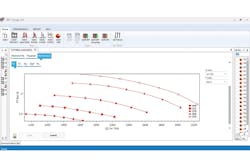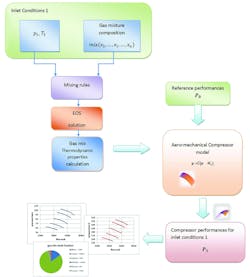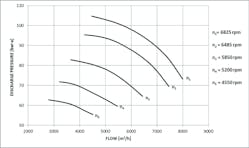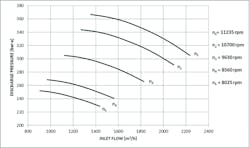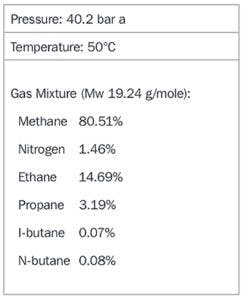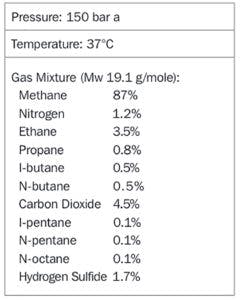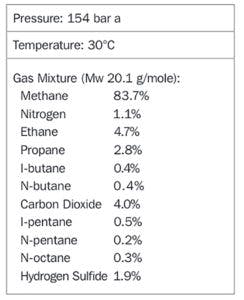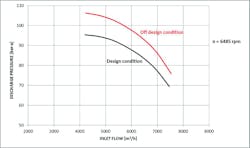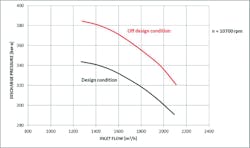Centrifugal compressors are a vital component within process plants. Compression machines are widely used in upstream as well as middle-stream plants, accomplishing critical missions for overall production goals in most cases. In these plants, compressors are often one of the most important assets due to their impact on capital investment as well as output loss caused by possible machine downtime and related maintenance and repair costs.
Understanding if the machine is running and working properly assumes a primary role. The capability to detect early indicators of eventual malfunctioning and timely identifying causes and possible remedies contribute to plant proficiency and minimize overall operational costs.
This direction is generally known as predictive maintenance. Today, a predictive approach is present across most industries and applied over several kinds of machinery. For the most common centrifugal machines, predictive techniques commonly implemented are connected to the vibrational and structural dynamic aspects of the machine rotor operational conditions. This phenomenological approach can be applied in the design stage where insight is given by OEMs to rotor dynamics, but often, it assumes a more practical and empirical form on the operation floor where machine vibrational parameters are measured and compared to acceptable limits and used merely for alarm triggering.
Table 1. Gas components
Predictive strategies based on the analysis of performance are increasing their presence as tools for diagnostic and evaluation of machine health status during operational time. For centrifugal pumps, for instance, the use of a machine model for the purpose of comparison of measured performance to design ones is relatively straightforward. For centrifugal compressors, the same process is more complex because of the dependency of compressor performance from the gas mix composition and operative inlet conditions (inlet pressure and inlet temperature). Therefore, for centrifugal compressors, an approach based on performance assessment requires a more complex machine model that should embed and couple several calculation capabilities from aeromechanics to thermodynamic.
One of the main difficulties for the analysis of centrifugal compressors’ operative performances arises from the need to have the available compressor performance map adjusted to actual inlet conditions. Usually, expected performances are described in terms of graphs of discharge pressures, discharge temperatures, polytropic heads, efficiencies and absorbed power, related to the design inlet gas conditions. In general, it may happen that inlet conditions in the field are different from specification conditions defined in the machine’s data sheets. A somewhat diffused practice consists in trying to reduce the complexity of the problem, considering the compressor head as invariant with inlet gas conditions and applying simplified machine formulas. While this method holds for very low pressure ranges and constant gas mixes, it introduces considerable errors as soon as the pressure increases and the gas mix variability is introduced into the problem.
In this situation, in order to assess compressor performance, it is necessary to adjust the design performance to operative conditions, taking into account the complexity of the problem and then compare that to measured values. This is basically the approach indicated on the ASME PTC10 (Performance Test Code on Compressors and Exhausters) standard.
This paper presents a general method and calculation tool for prediction of centrifugal compressor field performances in off-design condition. All numerical evaluations executed with Cmap software reported here have been developed using most-recent thermodynamic theories and machine aeromechanical models in accordance with PTC10.
Method
The following section provides a simple explanation of the calculation process used to evaluate the compressor performances. As a starting point, we consider that, for a centrifugal compressor, performances are strictly linked to the inlet gas conditions. This consideration is valid both to the design and off-design performance.
Begin with the availability of a centrifugal compressor performance curve, the relevant gas mix composition and thermodynamic conditions (pressure and temperature). Having this input data available, the software will perform all complex calculations — fully automated — and will produce the expected compressor performances for inlet pressures, inlet temperatures and gas mix compositions different for design/reference ones.
Calculation algorithms used are able to predict both machine behavior and thermodynamic real gas properties in off-design conditions. The list of gases that can be configured are shown in Table 1.
From a fluid dynamic point-of-view, a strict similarity of flow at each performance point is necessary. For this reason, the nondimensional parameters head coefficient, flow coefficient and Mach number must be conserved primarily.
The proposed method needs the following inputs:
a. Reference/design compressor maps: In general, these maps provided by the machine’s OEM give a reliable indication of the machine capability and are considered here as a starting point. In this case, input data should be affected by error, and these errors should be propagated in the outputs generated by this method. OEMs usually supply two different machine maps related to different moments of the compressor manufacturing process. "Expected" maps are usually issued in the commercial/design stage, as tested maps are issued at the end of the manufacturing process when the compressor is shop- or field-tested. In general, both maps may be used as input for the method, although "as tested" maps may be preferable.
b. Reference input conditions: Reference/design maps are linked to specific inlet conditions such as inlet pressure, inlet temperature and gas mix composition. This set of data shall be stated in order to proceed to off-design calculations.
c. Off-design input conditions: These are the conditions at the compressor inlet (pressure, temperature and gas mix composition) in which the new performance should be obtained. Off-design conditions may be alternative inlet conditions to be considered in the compressor design stage or may be the actual inlet condition in a specific time during compressor operation.
Starting from these described inputs, the method proceeds to calculate the compressor performances in off-design inlet conditions. Performance obtained as output from the described method should be referenced here as off-design conditions, i.e., design performance adjusted to off-design operative conditions. When reference is made to off-design performance in off-design operative condition during operational time, these performances should be indicated also as "actual" performance. Calculation of off-design performance requires the capability to extract the invariant information that describes the compressor behavior and use this information to rebuild the performance in new conditions. These calculations are intimately coupled with thermodynamic of gas compression and thermodynamic of real gas mixtures, so a variation in each component of the gas mixture is potentially able to manifest its effects, as well as a change of the inlet pressure and temperature. The connection among these different modeling areas allows the method to provide an accurate prediction of the compressor performance. The method does not require information about the internal parts of the machine, and it should not be considered a design tool, but more correctly, as an analysis tool that starts its job after the completion of the machine design stage.
Figure 1. How Cmap works
Case study: Prediction of performance in off-design conditions
The following describes how the presented method is applied using the Cmap software tool through two real cases. The compressors under study were running under off-design inlet conditions. The analysis developed with Cmap obtained the performances in these off-design conditions and a comparison to measured field values. In these case studies, the compressor performances map in design condition were available for both machines.
Figures 2 and 3 show the design maps (discharge pressure versus inlet flow) for compressor 1 and compressor 2 and relative design inlet conditions.
Figure 2. Design map compressor 1: discharge pressure versus inlet flow.
Figure 3. Design map compressor 2: discharge pressure versus inlet flow.
Table 2 indicates the inlet design gas conditions of compressor 1. Table 3 indicates the inlet design gas conditions of compressor 2.
Table 2. Inlet design gas condition compressor 1
Table 3. Inlet design gas condition compressor 2
Starting from these maps, the expected performance curves in the off-design conditions have been calculated. Tables 4 and 5 indicate the off-design inlet condition for compressor 1 and compressor 2.
Table 4. Inlet off-design condition compressor 1
Table 5. Inlet off-design gas condition compressor 2
Figures 4 and 5 compare the performance curves (discharge pressure versus inlet flow) in design and off-design condition.
Figure 4. Comparison of discharge pressure between design and off-design condition (compressor 1).
Figure 5. Comparison of discharge pressure between design and off-design condition (compressor 2).
The Cmap software was able to calculate, at the actual flow, the values of expected pressure, temperature, head and efficiency in the actual (off-design) conditions and then compare to the measured ones.
With reference to field values, Tables 6 and 7 compare the pressures and temperatures as read from transducers to the value predicted by the Cmap software.
Table 6. Compressor 1 predicted values
Table 7. Compressor 2 predicted values
The same comparison has been executed for head and polytropic efficiency.
In these tables, note that for compressor 1, the maximum error calculated is less than 1 percent, and for compressor 2, the error calculated is about 9 percent.
The analysis indicates that compressor 1 was running with operative performance aligned with design expectations; however, compressor 2 was running with performance not aligned with design expectations. This comparison gives the compressor analyst an important quantitative indication on the machine health status and should give the analyst an understanding of possible causes that may justify the observed difference.
The analysis developed using Cmap also obtained an evaluation of the efficiency deviation (difference between the actual compressor efficiency and the expected efficiency in the actual operative conditions). Time trends of calculation results provided a useful analytical basis for compressor maintenance decisions. The method has been profitably used to predict compressor performances and support planning of machinery maintenance activities.
Cmap performs the compressor performance prediction using different equations of state (EOS) depending on gas mix considered in the calculation. For hydrocarbon gas mixture, Lee-Kesler or PR EOS can be used. For Freon R134a, the MBWR EOS should be selected to determine the thermodynamic properties of the operating fluid.
Conclusion
Experiences with real machinery showed that the compressors’ performance prediction obtained with Cmap software are in very good alignment with OEM predictions and field measurement for machines in good condition. Also, experience showed that, in most cases, the deviation of a parameter, such as efficiency, indicates an incoming problem on the machine.
The proposed method may be used fully automated and could provide benefits for machines that work in high pressure ranges and under time-varying process conditions.
An automated application of Cmap may be able to provide continuous monitoring of machine performance and automated surveillance and diagnostics. Also, compressor protection from surge can be automatically and continuously updated to actual inlet conditions, overcoming limitations of actual systems.
Methods proposed and described in this paper can help to:
• Predict the performances of a centrifugal compressor in off-design condition. The prediction of compressor performances is accurate even at high pressures, where the ideal gas theory commonly used introduces considerable errors.
• Predict the modification of surge points in actual operative conditions, with different inlet pressures and temperatures and different operative gas, and to implement advanced protection from surge.
• Obtain useful indications on the health of the compressor (diagnostics) based on the capability to analyze the performances and efficiency of the machine in a simple and immediate way.
• Support decisions and planning of predictive maintenance and activities.
Massimiliano Di Febo is operation manager at IPC. He can be reached at [email protected].
Pasquale Paganini is a technical manager at IPC. He can be reached at [email protected]. For more information, visit ipc-eng.com or compressormap.com.
